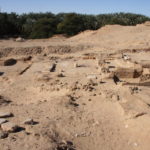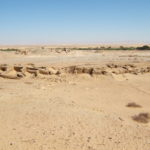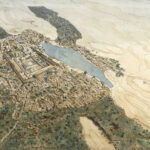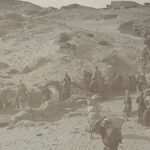ʿAYN AL-ṬURBA (HIBIS)
| Egyptian | Hb (Hꜣb.t) |
| Greek | Ἱβις | Ἱβιτῶν πόλις |
| Latin | Hibeos |
| Coptic | xhb |
| Arabic | عين الخراب | عين الطربة |
| English | Ayn al-Turba | Ayn al-Kharab |
| DEChriM ID | 4 |
| Trismegistos GeoID | 2786 |
| Pleiades ID | 776181 | PAThs ID | 185 |
| Ancient name | Hibis |
| Modern name | ʿAyn al-Ṭurba |
| Latitude | 25.481170 |
| Longitude | 30.556174 |
| Date from | -600 |
| Date to | 600 |
| Typology | City |
| Dating criteria | - |
| Description | ʿAyn al-Ṭurba, or ʿAyn al-Ḫarab, is situated a few hundred meters south of the cemetery of al-Baǧawāt. The Metropolitan Museum of Art (MMA) conducted excavations in the early 20th century, led by H. E. Winlock, focusing predominantly on the Temple of Hibis and the necropolis of al-Baǧawāt, with a limited area of ʿAyn al-Ṭurba being investigated. Unfortunately, the findings from ʿAyn al-Ṭurba remain unpublished, while those from Hibis and al-Baǧawāt are quite poorly documented. ʿAyn al-Ṭurba is mentioned briefly in the limited descriptions of the excavations of al-Baǧawāt in 1907, and additional fragments of information have been gleaned from H. E. Winlock’s personal correspondences, which reside in the archives of the MMA. Winlock identified the presence of Roman-period mud-brick structures consisting of a number of irregularly laid out rooms, some of which were barrel-vaulted, and a number of ornamented frescoes. He states that prior to the construction of these Roman buildings in the third century, the mound of ʿAyn al-Ṭurba was occupied by part of the cemetery of Hibis, with many of these houses constructed over subterranean tombs (Winlock, 1941: 2). A series of modifications of considerably poor quality were discernable, identified to have been from the Islamic period. Of the material recorded, the coins are of particular importance, ranging from the reign of Diocletian to that of Flavius Arcadius, ascertaining the occupation of the site in the fourth century (Lythgoe 1908: 208; 1909: 121). Additional excavations have since been carried out by the Supreme Council of Antiquities, commencing in 2006 and ceasing in 2009, with an additional campaign beginning in 2018, which is still ongoing. These excavations have revealed a number of structures, two of which are understood to be churches: one located in the south-west of the site, and the other slightly to the north-east of this first church. The church in the S-W shares many architectural similarities with other churches found in the Oasis, namely Šams al-Dīn, Dūš-north, Qaṣr Nisīma and ʿAyn al-Tarākwa (Ghica 2012: 199). Built within an earlier urban fabric and upon preexisting structures, the second church structure has been distinctly re-modelled in later phases of construction, and also shows traces of indiscernible Greek graffiti. Much of the area is generally understood by the local archaeologists to have been a Roman castrum. This interpretation, however, lacks sufficient evidence. Likewise, the interpretation of room number 6 (the western wall of which boasts an enormous frescoe) as part of a nunnery is similarly unfounded (unpublished site report from 2009, pages 7 and 14). A large collection of ostraka was uncovered in the initial MMA campaigns, which clearly documents a vibrant Christian community. Despite the fact that their provenance is lost, they have been understood to have come from al-Baǧawāt. This conclusion has since been revised due to the unlikelihood of ostraka of a domestic nature being prevalent in a cemetery and has since been understood to have originated from ʿAyn al-Ṭurba (Bagnall & Tallet 2015: 181). |
| Archaeological research | The Metropolitan Museum of Art (MMA) conducted excavations in the early 20th century, led by H. E. Winlock, focusing predominantly on the Temple of Hibis and al-Baǧawāt, with a limited area of ʿAin al-Ṭurba being investigated. Additional excavations have since been carried out by the Supreme Council of Antiquities (SCA), commencing in 2006 and ceasing in 2009, with an additional campaign beginning in 2018, which is still ongoing. |
• Alexander, C. 1937. “Accessions of Greek and Roman Antiquities.” The Metropolitan Museum of Art Bulletin 32/7: 157-177.
• Bagnall, R. S. and G. Tallet. 2015. “Ostraka from Hibis in the Metropolitan Museum of Art and the Archaeology of the City of Hibis.” Zeitschrift für Papyrologie und Epigraphik 196: 175-198.
• Ghica, V. 2012. “Pour une histoire du christianisme dans le désert Occidental d’Égypte.” Journal des Savants 2: 197-199.
• Ghica, V. 2016. “Vecteurs de la christianisation de l’Egypte au IVe siècle à la lumière des sources archéologiques.” In Acta XVI Congressus Internationalis Archaeologiae Christianae, Romae 22-28.9.2013, edited by O. Brandt and G. Castiglia, 242-243, 248-249 and fig. 9b. Città del Vaticano: Pontificio Istituto di Archeologia Cristiana.
• Hauser, W. 1932. “The Egyptian Expedition 1930-1931: The Christian Necropolis in Khargeh Oasis.” Bulletin of the Metropolitan Museum of Art 27/3.2: 38-50.
• Hill, M. and M-D. Nenna. 2003. “Glass from Ain et-Turba and Bagawat Necropolis in the Kharga Oasis, Egypt.” Annales du 15e Congrès de l’Association internationale pour l’histoire du verre, New York 2001, 88-92. Nottingham: Association internationale pour l’histoire du verre.
• Lythgoe, A.M. 1908. “The Oasis of Kharga.” The Metropolitan Museum of Art Bulletin 3/11: 203-208.
• Lythgoe, A. M. 1909. “The Egyptian Expedition.” The Metropolitan Museum of Art Bulletin 4/7: 119-123.
• Winlock, H. E. 1941. The Temple of Hibis in El Khargeh Oasis, I: The Excavations. New York: Metropolitan Museum of Art.


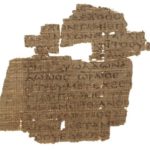
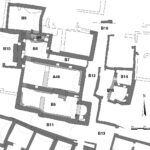
 Json data
Json data